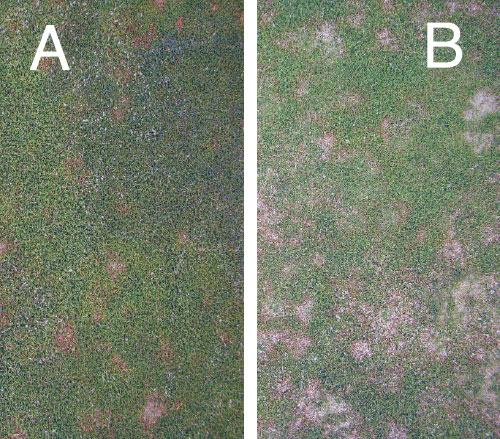Spray nozzle and fungicide mobility effects on Microdochium patch

Banner applied with XR11008 nozzles (coarse droplet size, A) provided better control of Microdochium patch than Banner applied with 1/4TTJ08 (extremely coarse droplet size, B).
Microdochium patch (Microdochium nivale) is a major disease on annual bluegrass (Poa annua) in the Pacific Northwest, Canada and northeastern coastal states. Little is known about the effects of spray-nozzle type used in combination with varying fungicide mobility on control of this disease.
A two-year field study was conducted at Oregon State to evaluate the effects of spray nozzles and fungicides with different mobility on control of Microdochium patch on a sand-based putting green with annual bluegrass.
The fungicides were applied with four different nozzles (XR11004 and XR11008 Flat Fans, which produce medium and coarse droplets, respectively, and the TurfJet Flat Fan 1/4TTJ04 and 1/4TTJ08, which produce extremely coarse droplets). The 04 and 08 nozzles sprayed at 30 psi and produced 0.35 gpm and 0.69 gpm, respectively. The study used two nozzle sizes to maintain a similar number of droplets at the two different spray volumes: 1 and 2 gallons per 1,000 sq. ft.
Fungicides used in this trial were Secure, Banner Maxx II and a difenoconazole solution, which have contact, acropetal and translaminar with limited acropetal mobility, respectively. Currently, the only available fungicide with difenoconazole is Briskway by Syngenta.
The fungicides were applied with a backpack sprayer with a three-nozzle hand-held boom at 30 psi. Five applications of Secure at 1.6 L/ha, Banner Maxx II at 3.2 L/ha and a difenoconazole solution at 1.3 L/ha were made every three weeks, ending in April.
Results showed that under high disease pressure, control is improved by using XR11004 and XR11008, compared with 1/4TTJ04 and 1/4TTJ08 nozzles. Sensitive paper analysis revealed significant differences between the four nozzles used, ranging from the XR11008 using a spray volume of 2 gallons per 1,000 sq. ft. providing 86-percent coverage, to the TurfJet 1/4TTJ04 using a spray volume of 1 gallon per 1,000 sq. ft. providing only 26-percent coverage.
Brian W. McDonald and Clint Mattox, Oregon State University, Dean K. Mosdell, Ph.D., Syngenta U.S., and Alexander R. Kowalewski, Ph.D., Horticulture, Oregon State University. Brian McDonald can be reached at brian.mcdonald@oregonstate.edu for more information.








